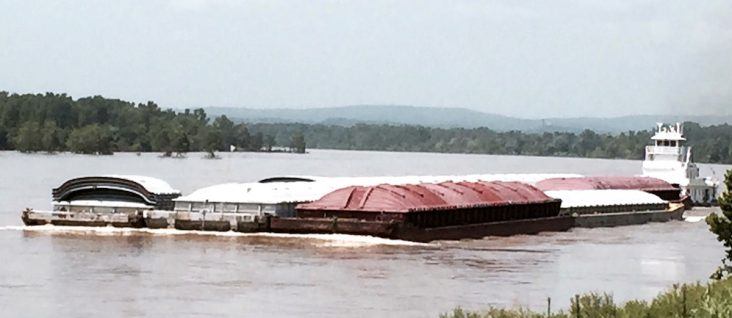Arkansas River tonnage up almost 29% through July
by August 12, 2020 3:33 pm 1,609 views

Fueled primarily by gains in sand/gravel/rock and wheat shipments, tonnage shipped on the Arkansas River during the first seven months of totaled 6.136 million tons, up 28.8% over the same period in 2019 – a period with historic river flooding that significantly slowed traffic.
River tonnage in 2019 totaled 8.48 million tons, down 22% from 2018. Tonnage in the first seven months of 2020 is down 10.2% from the same period in 2018.
July tonnage on the river totaled 887,000 tons, well ahead of the 501,173 tons in July 2019 and better than the 859,806 in July 2018.
The Arkansas River system is 445 miles long and stretches from the confluence of the Mississippi River to the Port of Catoosa near Tulsa, Okla. The controlled waterway has 18 locks and dams, with 13 in Arkansas and five in Oklahoma. The river also has five ports: Pine Bluff, Little Rock, Fort Smith, Muskogee, Okla., and the Tulsa Port of Catoosa in Oklahoma.
Marty Shell, president of Van Buren-based Five Rivers Distribution, which has port operations in Fort Smith and Van Buren, credited agri commodities with improved river traffic.
“The system saw a strong wheat harvest in the north and we should see a strong soybean and corn harvest as well this year. Southbound grains will be a strong move with northbound bulk commodities creating demand for barge freight rates,” Shell said.
Bryan Day, executive director of the Port of Little Rock, said 2020 has been a “tough year” because of COVID-19 economic disruptions but some commodities are still in demand.
“Bulk commodities including aggregates, bauxite, fertilizer and wetcake have had good barge/tonnage activity this year and should continue this trend. Inbound steel coils have been most adversely affected by the negative economic impacts of Covid,” Day wrote in a note to Talk Business & Politics.
He said August traffic could be lower because of a two week maintenance closure of the David Terry Lock & Dam (Lock & Dam 6) in Pulaski County. Day said some tonnage typically shipped on the river may be diverted to rail or truck.
While optimistic about future river traffic, Shell said the pandemic continues to cause economic uncertainty.
“We are still optimistic about the third and fourth quarter of 2020, but with the low demand of steel and other goods that travel by water it’s still a waiting game on how bad this recession will be,” he said.
Following are the top five shipment categories by tonnage for the first seven months of 2020, with the percentage change from the same period in 2019.
• Sand, gravel, rock: 2.028 million tons (up 72%)
• Chemical, fertilizer: 1.253 million tons (up 10%)
• Wheat: 752,273 tons (up 100%)
• Iron & steel: 573,112 tons (down 35%)
• Soybeans: 554,100 tons (down 4%)
